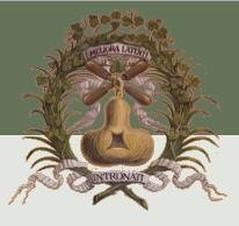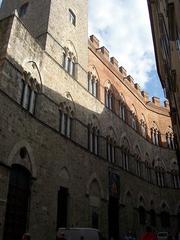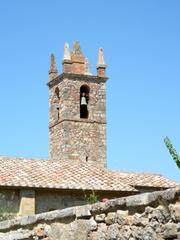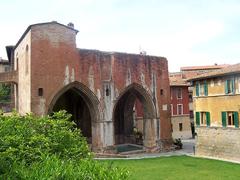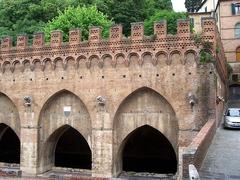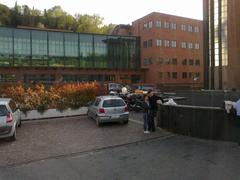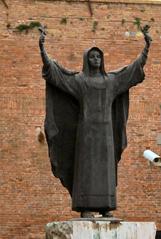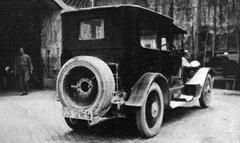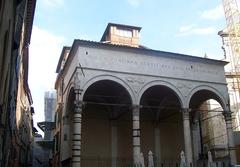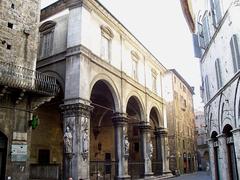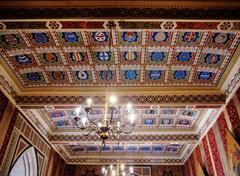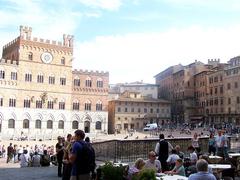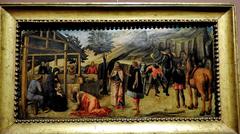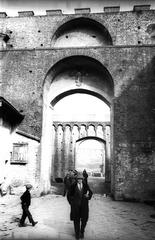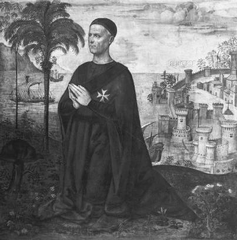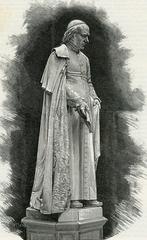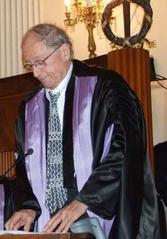
Basilica of San Francesco Siena: Visiting Hours, Tickets, and Historical Sites Guide
Date: 03/07/2025
Introduction
The Basilica of San Francesco in Siena stands as a profound testament to the city’s Franciscan heritage, architectural innovation, and artistic achievement. Built in the early 13th century and expanded during the 14th century, the basilica has served for centuries as a spiritual haven, a center for community life, and a repository for Sienese art. Its austere Gothic design, luminous stained glass, and world-class frescoes invite visitors into a space of both solemnity and inspiration. Centrally located at Piazza San Francesco, the basilica offers free entry and guided tours, making it accessible to pilgrims, art lovers, and travelers eager to explore Siena’s religious and cultural heart (churchesofflorence.com; italyscapes.com; Evendo).
This guide provides comprehensive information on visiting hours, tickets, accessibility, and travel tips, as well as insights into the basilica’s history, artistic treasures, and enduring role in Siena’s community.
Table of Contents
- Introduction
- Historical Overview
- Artistic Heritage
- Architectural Features
- Interior Decoration & Artistic Elements
- Lighting and Experience
- Practical Visitor Information
- Religious and Cultural Significance
- Restoration and Preservation
- FAQ
- Conclusion & Call to Action
- References
Historical Overview
Origins and Foundation
The Franciscans arrived in Siena around 1226, soon after the death and canonization of Saint Francis of Assisi. Their rapid growth in the city prompted the construction of a modest oratory, which was soon replaced by a larger church to accommodate the increasing congregation. Construction of the current basilica began in 1326, with support from influential Sienese families whose patronage is evident in the chapels and artworks within (churchesofflorence.com).
Architectural Evolution
The basilica exemplifies Italian Gothic architecture, with an austere brick façade, pointed arches, and a spacious nave. Initially designed with a single wide nave and timber roof, the church was continually expanded and embellished with side chapels funded by local nobility. The 18th-century brought a new bell tower (campanile) designed by Paolo Posi, while fires and neglect led to significant restoration efforts, particularly after the destructive fire of 1655 (churchesofflorence.com). Nineteenth and twentieth-century restorations aimed to preserve the basilica’s medieval character.
Artistic Heritage
Frescoes and Altarpieces
The basilica’s chapels once featured extensive fresco cycles by leading Sienese artists, notably Ambrogio and Pietro Lorenzetti. The Lorenzetti brothers’ frescoes, rediscovered in the 19th century after centuries under whitewash, depict scenes such as the Ordination of Saint Louis of Toulouse and the Martyrdom of the Franciscan Friars (churchesofflorence.com). Other highlights include a Crucifixion by Pietro Lorenzetti and a Lamentation by Vecchietta. Many original altarpieces by Perugino and Sodoma were lost in the 1655 fire, with surviving fragments now housed in museums across Europe.
Lost and Dispersed Art
Over the centuries, much of the basilica’s original art has been lost, dispersed, or relocated. Notable surviving works, such as Taddeo di Bartolo’s panel of Louis of Toulouse, are now in the Diocesan Museum. The basilica’s artistic legacy, though diminished, remains a vital part of Siena’s cultural patrimony (churchesofflorence.com).
Architectural Features
Exterior and Façade
The basilica’s Neo-Gothic brick façade, completed in the early 20th century, is austere but harmonious, intentionally contrasting with more elaborate churches in Siena (viafrancigena.visittuscany.com). The marble portal and rose window remain from the 15th-century façade by Francesco di Giorgio Martini (terredisiena.it), adorned with sculptures of Saint Francis, Saint Bernardino, and the Virgin and Child (italyscapes.com).
Bell Tower and Marble Symbolism
The bell tower, built in the 1760s, is restrained in design, complementing the basilica’s overall aesthetic (italyscapes.com). Once clad in black and white marble stripes—Siena’s civic colors—these elements were removed in 19th-century restorations, leaving exposed brickwork. Remaining marble decorations on the façade bear symbols of the four evangelists and coats of arms of Siena and its patrons (terredisiena.it).
Plan and Layout
The basilica uses an Egyptian cross plan, with a single wide nave and intersecting transept, favoring communal worship (wikipedia). Eight chapels line the nave, each containing significant artworks and monuments. The main chapel, designed in the 19th century, features a notable stained-glass window by Leopoldo Maccari (terredisiena.it).
Interior Decoration & Artistic Elements
Marble Stripes and Optical Effects
The interior is renowned for its alternating black and white marble stripes, creating a striking optical effect emblematic of Sienese churches (terredisiena.it).
Stained Glass
The basilica’s 36 stained glass windows, crafted in Munich between 1885 and 1890, fill the nave with colored light. Many were reconstructed after WWII (italyscapes.com), and the main chapel’s window by Maccari is a highlight of Italian glasswork (terredisiena.it).
Frescoes and Sculptures
Artworks include the Coronation of the Virgin by Sassetta and Sano di Pietro, Nativity by Il Sodoma, Crucifixion by Pietro Lorenzetti, and other masterworks by Sienese artists (wikipedia; terredisiena.it). The nave features paintings by Nasini, Casolani, and Rustici, and the left side preserves a Renaissance portal by Francesco di Giorgio Martini.
Crypt and Cloisters
The crypt now houses the University of Siena’s Faculty of Economics library, while the adjacent cloisters, once part of the Franciscan convent, offer a serene retreat (visitsienaofficial.it; to-tuscany.com).
Lighting and Spatial Experience
Large Gothic windows flood the basilica with natural light, enhancing the linearity and simplicity of the space. The interplay of light and shadow, together with reflective marble, creates a contemplative atmosphere in tune with Franciscan ideals (terredisiena.it).
Practical Visitor Information
Visiting Hours
- Typical hours: Daily, 7:00 AM to 7:00 PM.
- Hours may vary during holidays or special events; check official sources for updates.
Tickets and Tours
- Entry is free; donations are appreciated.
- Guided tours are available through local operators or the Siena tourist office. Advance booking is recommended, especially in peak season.
Accessibility
- The basilica is wheelchair accessible, with ramps at the main entrance and level floors. Some chapels may have steps or uneven flooring.
Travel Tips
- Visit early morning or late afternoon for quiet and optimal lighting (to-tuscany.com).
- Nearest bus stop: Risalita San Francesco (lines 525, 567, 568) (italyscapes.com).
- Wear comfortable shoes for Siena’s hilly terrain.
Nearby Attractions
- Siena Cathedral (Duomo)
- Piazza del Campo
- Palazzo Pubblico
- Fontebranda Fountain All within walking distance, ideal for an itinerary of Siena’s historical sites.
Religious and Cultural Significance
Franciscan Spirituality
Dedicated to Saint Francis, the basilica has long been a center for Franciscan preaching, charity, and engagement with Siena’s urban poor. Its chapels reflect centuries of family patronage and local devotion.
Notable Events and Figures
The basilica has hosted sermons by figures like San Bernardino of Siena, commemorated in art by Sano di Pietro. The Piccolomini family, among others, left an indelible mark through their patronage and commissioned artworks (churchesofflorence.com).
Pilgrimage and Community Life
The basilica remains an active place of worship and a pilgrimage site, especially during major religious events (Visit Siena Official). It also hosts concerts, lectures, and exhibitions, making it a vibrant center for Siena’s spiritual and cultural life (Evendo).
Restoration and Preservation
Restoration efforts have been ongoing since the 19th century, particularly after the rediscovery of the Lorenzetti frescoes and the destruction caused by fires and neglect. These efforts ensure the survival of the basilica’s artistic and architectural treasures for future generations (churchesofflorence.com).
Frequently Asked Questions (FAQ)
What are the Basilica of San Francesco visiting hours?
- Daily from 7:00 AM to 7:00 PM, with possible variations during holidays.
Is there an entrance fee or tickets required?
- No. Entry is free; donations are appreciated.
Are guided tours available?
- Yes. Book through the Siena tourist office or local agencies.
Is the basilica accessible for visitors with disabilities?
- Yes. Main entrances have ramps, but some interior areas may have steps.
Can I take photographs inside?
- Photography is generally permitted. Please avoid flash and respect services.
What nearby attractions can I visit?
- Siena Cathedral, Piazza del Campo, Palazzo Pubblico, Fontebranda Fountain.
Conclusion & Call to Action
The Basilica of San Francesco is a cornerstone of Siena’s spiritual and cultural identity. Its harmonious blend of Gothic architecture, Franciscan heritage, and artistic masterpieces offers a uniquely serene experience for visitors. With free admission, central location, and accessible facilities, the basilica invites everyone—from art lovers to pilgrims—to explore its sacred spaces and rich history.
For current visiting hours, guided tours, and interactive maps, download the Audiala app or consult Siena’s official tourism resources. Stay updated on special events, and prepare to immerse yourself in the spiritual and artistic treasures that define this remarkable basilica.
References
- Basilica of San Francesco in Siena: Visiting Hours, Tickets, History & Travel Tips, 2025, Churches of Florence (http://www.churchesofflorence.com/sienasanfran.htm)
- Visiting Basilica of San Francesco in Siena: Hours, Tickets & Historical Insights, 2025, Italyscapes (https://www.italyscapes.com/places/tuscany/siena/churches/basilica-of-san-francesco/)
- Basilica of San Francesco Siena: Visiting Hours, Tickets, and Spiritual Highlights, 2025, Evendo (https://evendo.com/locations/italy/siena/landmark/basilica-of-san-francesco)
- Basilica of San Francesco in Siena, 2025, Visit Siena Official (https://visitsienaofficial.it/en/the-basilica-of-san-francesco/)
- Basilica of San Francesco in Siena, 2025, Terre di Siena (https://www.terredisiena.it/en/places-of-worship/basilica-of-san-francesco-in-siena/)
- Visiting the Basilica of San Francesco in Siena: Hours, Tickets, and Nearby Historical Sites, 2025, ItalyGuides.it (https://www.italyguides.it/en/tuscany/siena/interactive-map-of-siena)
- An Extraordinary Episode of Franciscan Art in Siena: The Cycle of Pietro and Ambrogio Lorenzetti, 2025, Finestre sull’Arte (https://www.finestresullarte.info/en/works-and-artists/an-extraordinary-episode-of-franciscan-art-in-siena-the-cycle-of-pietro-and-ambrogio-lorenzetti)
- Basilica of San Francesco Siena: Visiting Hours, Tickets, and Spiritual Highlights, 2025, Trek Zone (https://trek.zone/en/italy/places/238469/basilica-of-san-francesco-siena)

